Who would have expected to find Singapore’s oldest Hindu temple sitting in the heart of Chinatown?
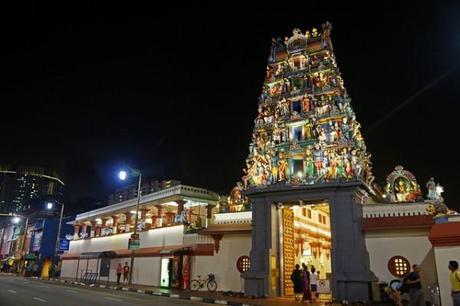
By: Allie_Caulfield
It’s unexpected, to be sure, and the story behind it is interesting.
Background of Sri Mariamman Temple
Sri Mariamman Temple dates back to 1827, eight years after the British East India Company established a trading settlement in Singapore. It wasn’t supposed to be there originally; the British first offered land in Telok Ayer Street for a Hindu Temple along with sites for a Chinese temple and a mosque. However, the Hindus turned down the offer because Telok Ayer did not have the convenient source of fresh water that Hindus require for their rituals.
After the Brits offered this site at South Bridge Road in 1823 Naraina Pillay a treasury clerk who was the first recorded Indian immigrant to Singapore, built a humble wood and atap hut on the spot. It was dedicated to the goddess Mariamman, who nourishes and protects all things. Mariamman is also known for her healing powers in epidemic diseases such as cholera and smallpox, both of which were rampant in the jungle environment of early Singapore.
In 1843 immigrants from districts in South India replaced it with something more substantial. The temple soon became a refuge for new immigrants who stayed there till they found work and accommodation.
The temple has been rebuilt and expanded to better serve the Hindu community. It now includes a 3-story complex with an auditorium and rooms for weddings, meetings, cultural events, and so forth. That said, the oldest parts of the temple are from the original 1843 structure.
Temple architecture
Sri Mariamman Temple is best known for the colorful and elaborately carved 6-tiered tower over the temple gates. Towers like this, called gopuram, are quite typical in Dravidian architecture. (The famous Angkor Wat in Cambodia was also based on this style.) Although not every one is painted like this one, every gopura is made from sandstone, soapstone or granite and is intricately carved with Hindu deities and mythological beasts. It is always pyramid-shaped, tapering straight up toward the sky.
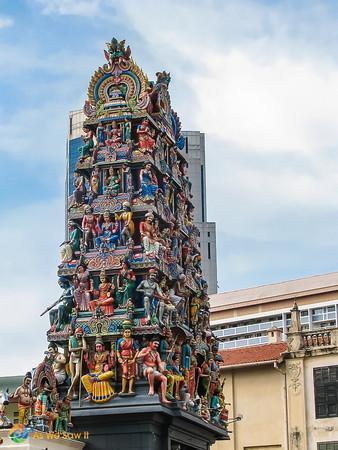
Next to the gopura at this temple are sculptures of two important HIndu gods: Murugan and Krishna. Murugan is the god of war and the Tamil patron deity. Krishna is easy to spot; he is always a blue-skinned cowherd boy playing his flute. He is greatly beloved by Hindus as a divine warrior, gentle lover, and teacher.
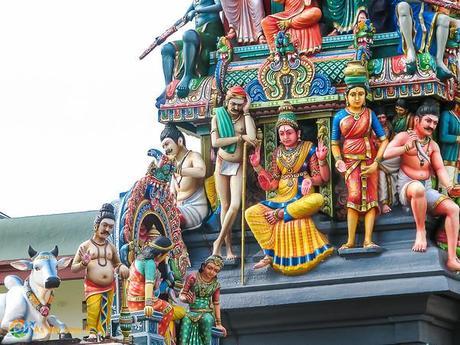
Beneath the gopura are imposing wooden doors. Their massive size is quite deliberate, designed to remind the worshippers of their insignificance in comparison to the divine. And the grids of bells on the doors? Devotees believe that ringing them will bring good luck.
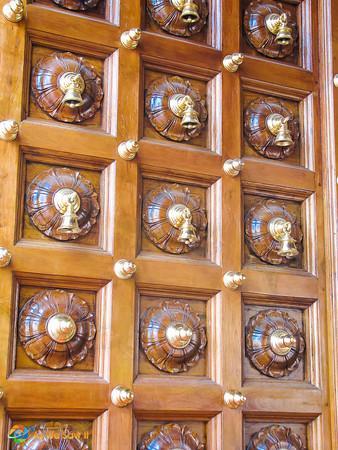
The inside of the temple is as colorful as the outside, with colorful paintings everywhere, even on the ceiling. The main prayer hall contains the central shrine of Mariamman. On both sides are the shrines of two secondary deities – Murugan (you saw him outside) and Rama. Nearby are a series of free-standing, dome-roofed shrines for different deities.
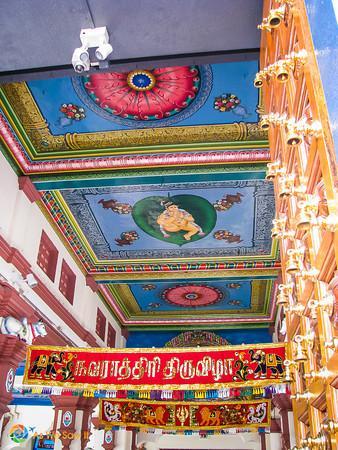
Interesting facts about the temple
In the early evening, priests, worshippers, and musicians take part in age-old rituals and make beautifully-arranged offerings. Their offerings are chosen for what they symbolize; for instance, mango and coconut leaves are signs of purity and bananas symbolize abundance. Worshipers will always be walking in a clockwise direction, for an odd number of times, in order to have good luck.
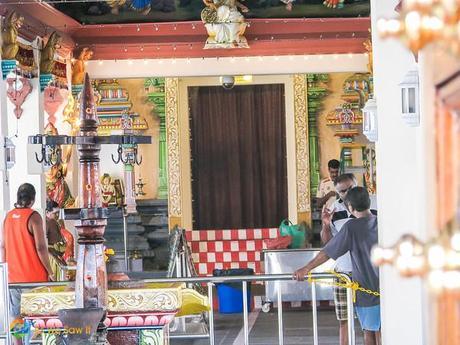
Two nearby streets got their names because of this temple: Temple Street (for obvious reasons) and Pagoda Street (because of the shape of the temple’s gopura).
Visiting
Sri Mariamman Temple is a Singapore National Monument and is owned by Hindu Endowments Board. Entrance is free, but they request a donation of 3 dollars if you have your camera. It’s worth it though; you will come home with beautiful pictures.
Hours: 7 am-12 noon, 6-9 pm
Tip: Take off your shoes before entering, and dress conservatively.
Tip: If you are in Singapore in the autumn, one of the temple’s main festivals is held between mid-October and mid-November each year. An annual timiti or fire walking ceremony is held about a week before Deepavali, the Festival of Lights.
Do you enjoy architecture?
Dan and I were so fascinated by the variety of architecture in Singapore that we couldn’t resist creating a series of posts about them. So far, the interesting buildings include: Marina Bay Sands, The Gateway, Buddha Tooth Relic Temple, and Sri Mariamman Temple, with more to come.
email (Visited 3 times, 3 visits today)
